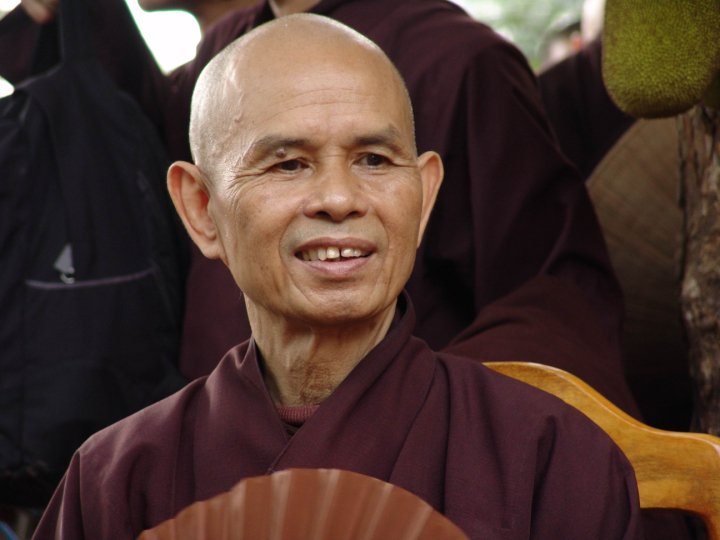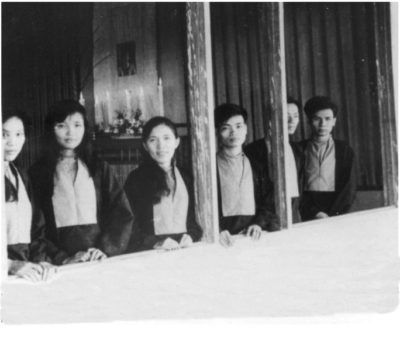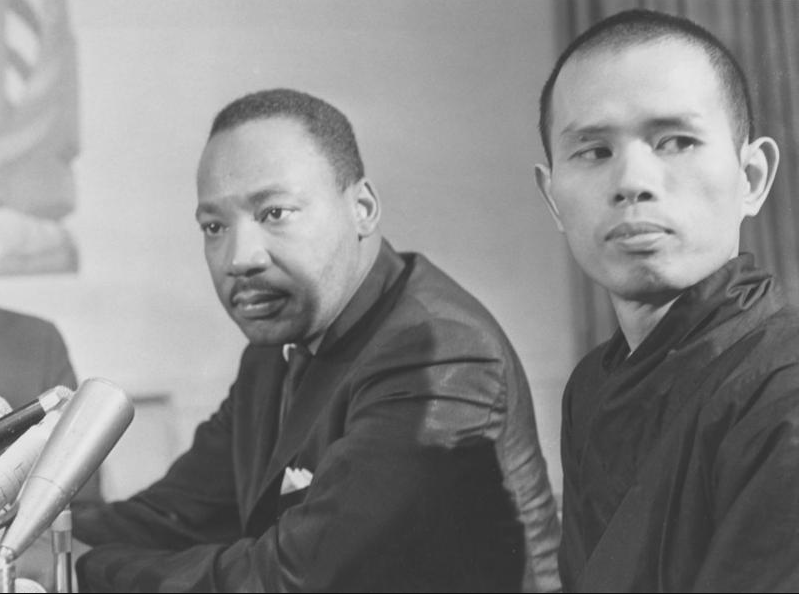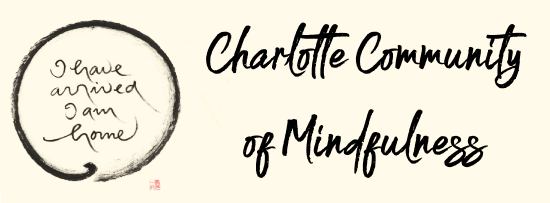11 October 1926-22 January 2022
Extended biography: Thich Nhat Hanh: Extended Biography | Plum Village

Zen Master Thich Nhat Hanh was a global spiritual leader, poet and peace activist, revered throughout the world for his powerful teachings and bestselling writings on mindfulness and peace. His key teaching is that, through mindfulness, we can learn to live happily in the present moment—the only way to truly develop peace, both in oneself and in the world. A prolific writer, Thich Nhat Hanh published over 100 titles in English, ranging from classic manuals on meditation, mindfulness and Engaged Buddhism, to poems, children’s stories, and commentaries on ancient Buddhist texts. He sold over three million books in America alone, some of the best-known include Being Peace, Peace Is Every Step, The Miracle of Mindfulness, The Art of Power, True Love and Anger.
Thich Nhat Hanh was a pioneer in bringing Buddhism to the West, founding six monasteries and dozens of practice centers in America and Europe, as well as over 1,000 local mindfulness practice communities, known as “Sanghas.” He built a thriving community of over 700 monks and nuns worldwide, who, together with his tens of thousands of lay students, apply his teachings on mindfulness, peace-making and community-building in schools, workplaces, businesses – and even prisons – throughout the world. Thich Nhat Hanh, was a gentle, humble monk – the man Martin Luther King called “An Apostle of peace and nonviolence.” The media has called him “The Father of Mindfulness,” “The Other Dalai Lama” and “The Zen Master Who Fills Stadiums.”
Biography
Born in central Vietnam in 1926, Thich Nhat Hanh entered Tu Hieu Temple, in Hue city, in 1942 as a novice monk at the age of sixteen. As a young bhikshu in the early 1950s he was actively engaged in the movement to renew Vietnamese Buddhism. He was one of the first bhikshus to study a secular subject at university in Saigon, and one of the first six monks to ride a bicycle. When war came to Vietnam, monks and nuns were confronted with the question of whether to adhere to the contemplative life and stay meditating in the monasteries, or to help those around them suffering under the bombings and turmoil of war. Thich Nhat Hanh was one of those who chose to do both, and in doing so founded the Engaged Buddhism movement, coining the term in his book Vietnam: Lotus in a Sea of Fire.
His life was dedicated to the work of inner transformation for the benefit of individuals and society. In 1961 he travelled to the United States to teach Comparative Religion at Princeton University and the following year went on to teach and research Buddhism at Columbia University. He returned to Vietnam in 1963 to play a leading role in the Buddhist movement for peace and social action. He founded the School of Youth and Social Service, a grass-roots relief organization of 10,000 volunteers based on the Buddhist principles of non-violence and compassionate action.

He also founded the Van Hanh Buddhist University in Saigon, La Boi publishing House, and an influential peace activist magazine. In 1966 he established the Order of Interbeing, a new order based on the traditional Buddhist Bodhisattva precepts. On May 1st, 1966 at Tu Hieu Temple, Thich Nhat Hanh received the ‘lamp transmission’ from Master Chan That, becoming a dharma teacher of the Lieu Quan Dharma Line in the 42nd generation of the Lam Te Dhyana school (“Lin Chi Chan” in Chinese or “Rinzai Zen” in Japanese).

A few weeks later he travelled once more to the U.S. and Europe to make the case for peace and to call for an end to hostilities in Vietnam. It was during this 1966 trip that he first met Dr Martin Luther King Jr., who nominated him for the Nobel Peace Prize in 1967. Yet as a result of this mission both North and South Vietnam denied him the right to return to Vietnam, and he began a long exile of 39 years. Thich Nhat Hanh continued to travel widely, spreading the message of peace and brotherhood, lobbying Western leaders to end the Vietnam War, and leading the Buddhist delegation to the Paris Peace Talks in 1969.
He also continued to teach, lecture and write on the art of mindfulness and ‘living peace’, and in the early 1970s was a lecturer and researcher in Buddhism at the University of Sorbonne, Paris. In 1975 he established the Sweet Potato community near Paris, and in 1982 they moved to a much larger site in the south west of France, soon to be known as “Plum Village”. Under Thich Nhat Hanh’s spiritual leadership Plum Village has grown from a small rural farmstead to what is now the West’s largest and most active Buddhist monastery, with over 200 resident monastics and up to 8,000 visitors every year, who come from around the world to learn “the art of mindful living.”
Plum Village welcomes people of all ages, backgrounds and faiths at retreats where they can learn walking meditation, sitting meditation, eating meditation, total relaxation, working meditation and stopping, smiling, and breathing mindfully. These are all ancient Buddhist practices, the essence of which Thich Nhat Hanh has simplified and developed to be easily and powerfully applied to the challenges and difficulties of our times. In the last twenty years over 100,000 retreatants have made a commitment to follow Thich Nhat Hanh’s modernized code of universal global ethics in their daily life, known as “The Five Mindfulness Trainings.”
Thich Nhat Hanh founded Wake Up, a worldwide movement of thousands of young people training in these practices of mindful living, and he has launched an international Wake Up Schools program training teachers to teach mindfulness in schools in Europe, America and Asia.
Thich Nhat Hanh was also an artist, and his unique and popular works of calligraphy – short phrases and words capturing the essence of his mindfulness teachings – have since 2010 been exhibited in Hong Kong, Taiwan, Canada, Germany, France, and New York. In the last decade Thich Nhat Hanh has opened monasteries in California, New York, Vietnam, Paris, Hong Kong, Thailand, Mississippi and Australia, and Europe’s first “Institute of Applied Buddhism” in Germany. Mindfulness Practice Centers in the Plum Village tradition offer special retreats for businessmen, teachers, families, healthcare professionals, psychotherapists, politicians, young people as well as veterans and Israelis and Palestinians.
It is estimated that over 45,000 people participate in activities led by Plum Village monks and nuns in the US and Europe every year. In recent years Thich Nhat Hanh has led events for US Congressmen and -women, and for parliamentarians in the UK, Ireland, India and Thailand. He has addressed UNESCO in Paris, calling for specific steps to reverse the cycle of violence, war and climate change, as well as the World Parliament of Religions in Melbourne. On a visit to the US in 2013 he was invited to lead high-profile mindfulness events at Google, The World Bank, the Harvard School of Medicine, and a special event for the CEO’s of some of the largest technology companies in Silicon Valley.
On 11 November 2014, a month after his 88th birthday, and following several months of rapidly declining health, Thich Nhat Hanh suffered a severe stroke. In January 2016, after over a year of intensive rehabilitation, Thich Nhat Hanh returned to his community, spending 2016 in Plum Village and 2017-18 in his monastery in Thailand. In October 2018 he returned to Tu Hieu Temple in Hue, Vietnam with the intention to live out his days in the monastery where he first ordained.
In 2005 Thich Nhat Hanh was asked: “You will be 80 this year. Do you plan to retire as a spiritual teacher at any point?” This is the answer he gave:
“In Buddhism we see that teaching is done not only by talking, but also by living your own life. Your life is the teaching, is the message. And since I continue to sit, to walk, to eat, to interact with the Sangha and people, I continue to teach, even if I have already encouraged my senior students to begin to replace me in giving Dharma talks. In the last two years, I have asked Dharma teachers, not only in the monastic circle but also in the lay circle, to come up and give Dharma talks. Many of them have given wonderful Dharma talks. Some Dharma talks have been better than mine. I see myself in my continuation, and I will not retire. I’ll continue to teach, if not by Dharma talks then in my way of sitting, eating, smiling, and interacting with the Sangha. I like to be with the Sangha.
Even if I don’t give a Dharma talk, I like to join walking meditation, sitting meditation, eating in mindfulness and so on. So don’t worry. When people are exposed to the practice, they are inspired. You don’t need to talk in order to teach. You need to live your life mindfully and deeply. Thank you.”
Our beloved teacher Thich Nhat Hanh, founder of the International Plum Village Community of Engaged Buddhism, passed away peacefully at Từ Hiếu Temple in Huế, Vietnam on 22nd January, 2022, at the age of 95.
Oprah Winfrey interview with Thich Nhat Hanh: Video (youtube)
Article: https://www.oprah.com/spirit/oprah-talks-to-thich-nhat-hanh/all
Thich Nhat Hanh Dharma Talk: Introduction to Mindfulness
